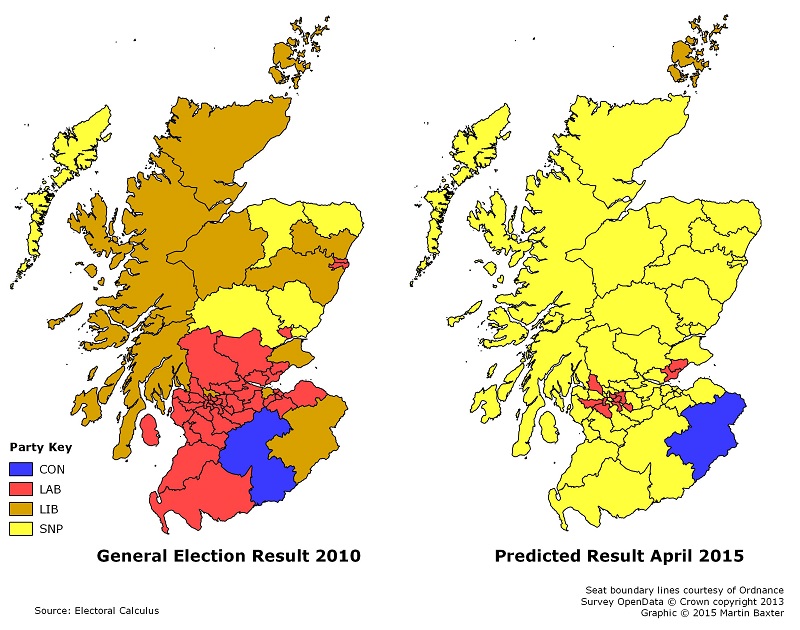Scotland has three distinct political areas. The largest is the populous central belt of Edinburgh, Glasgow and their surrounding urban areas. In the more distant past Conservatives were popular here - there were eight Tory MPs in 1983 in the two big cities alone. But recently this belt has become a stronghold of the dominant Scottish Labour establishment.
North of the central belt lie the rural areas up to the Highlands, the north-east and the islands. Traditionally the north has been the home of Liberal Democrats and the SNP.
Finally the Borders, lying between the central belt and northern England, has its own rural politics with a Conservative and Liberal tradition less fertile for Scottish nationalism.
These divisions have faint echoes of the eighteenth century conflicts in Scotland between the traditional rural Jacobite north and the government-supporting enlightenment urban lowlands. Recently, as then, it appeared the establishment was in control.

The SNP have triumphantly broken out of their north-east heartland and swept almost all before them. They are predicted to gain strongly not just in the north, but also in the central belt. All of Edinburgh and much of the Glasgow area is predicted to go yellow. Even the Borders can't resist the nationalist advance.
Labour are reduced to a rump of hard-core seats around Glasgow and in Fife. The Liberal Democrats are just clinging on to the Norse-leaning Northern Isles. And in the Borders the Conservatives still have some strength.
Some big political names may lose their seats. Electoral Calculus and seat-level polling agree Danny Alexander will lose Inverness; Charles Kennedy will lose Ross Skye and Lochaber; and Labour won't keep Alistair Darling's former Edinburgh seat. Scottish Labour leader Jim Murphy will probably only just hang on.
The changing affiliations of Scots can be seen in the voter migration diagram above. This depicts the changes in party support for one hundred typical Scottish voters since the last general election. "Lost" supporters for a party are shown in grey, "gained" supporters carry a plus sign, and the arrows show the movements since 2010.
The political sea-change has been caused by the massive post-referendum migration of Labour and Lib Dem voters to the SNP. The Greens and UKIP have gained a little, but will not win any seats. Only the Conservatives have remained relatively stable, though this will not translate into more than one or two seats this time.
The referendum has transformed the Scottish political landscape and the SNP have put together an unprecedented coalition of voters across Scotland. Can the SNP hold that together if they co-operate with Labour, or will they seek Scottish unity through opposition to Westminster politics?
The underlying data for voter migration comes from two YouGov surveys of Scotland conducted between 8-20 April 2015 surveying 2,167 people ( Times survey 1, Times survery 2). The raw data from the YouGov tables tells us the percentage distribution of current voting intention, separately for each category of 2010 voter.
| 2010 Vote | ||||
|---|---|---|---|---|
| VI | Con | Lab | Lib | SNP |
| Con | 70 | 5 | 11 | 5 |
| Lab | 11 | 48 | 19 | 3 |
| Lib | 5 | 2 | 22 | 0 |
| SNP | 10 | 43 | 44 | 91 |
| UKIP | 3 | 1 | 1 | 1 |
| Green | 1 | 1 | 2 | 0 |
| Other | 0 | 0 | 0 | 0 |
These data can be transformed into a migration table showing the number of voters broken down both by their 2010 voting and by their current voting intention:
| 2010 Voters | Total (April 2015 vote share) | ||||||
|---|---|---|---|---|---|---|---|
| Con | Lab | Lib | SNP | UKIP | Green | ||
| Con | 11.5 | 1.3 | 2.0 | 1.1 | 0.0 | 0.0 | 15.9 |
| Lab | 1.8 | 20.4 | 3.7 | 0.5 | 0.0 | 0.0 | 26.4 |
| Lib | 0.7 | 0.1 | 4.0 | 0.0 | 0.0 | 0.0 | 4.8 |
| SNP | 1.7 | 17.7 | 8.3 | 18.1 | 0.0 | 0.0 | 45.8 |
| UKIP | 0.7 | 1.7 | 0.3 | 0.2 | 0.7 | 0.0 | 3.6 |
| Green | 0.2 | 0.8 | 0.5 | 0.1 | 0.0 | 0.7 | 2.4 |
| Total (May 2010 vote share) | 16.7 | 42.0 | 18.9 | 19.9 | 0.7 | 0.7 | 98.9 |
Totals do not add to 100 because of other parties which received 1.1 per cent of the votes. It was assumed that no UKIP or Green voter switched party. The raw data was adjusted by the minimum necessary to achieve the correct row and column sums - which need to be equal to the current and past vote shares respectively.